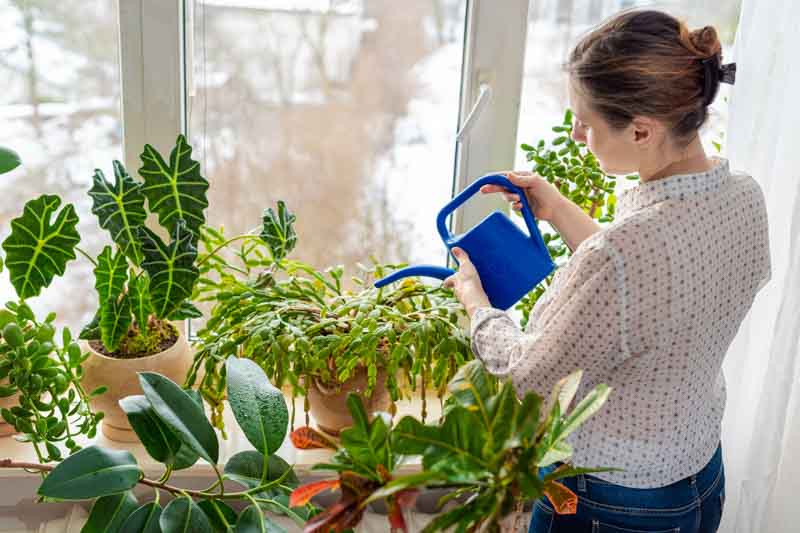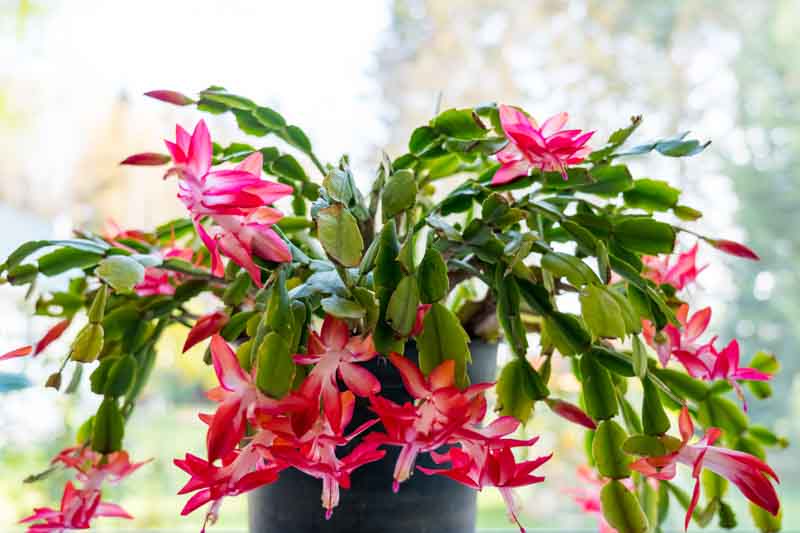Christmas Cactus, Epiphyllum × buckleyi
Christmas Cactus (Schlumbergera x buckleyi) is a popular houseplant prized for its vibrant, tubular flowers that bloom in winter. Unlike typical cacti, it lacks sharp spines, making it friendly for household placement.
Native: Christmas Cactus originates from the coastal mountains of southeastern Brazil, where it grows in cloud forests.
Growth habit: It’s an epiphytic cactus, meaning it naturally grows on trees. Its habit is pendulous, with branches hanging downward.
Size: The plant generally reaches a height of 6-12 inches (15-30 cm), with a spread of about 18-24 inches (45-60 cm).
Flowers: Its flowers are tubular and come in hues of pink or red, sometimes even white or yellow, with soft petal-like structures.
Blooming season: It primarily blooms in late fall to winter, giving it its common name, Christmas Cactus.
Hardiness: Christmas cactus prefers temperatures between 60-70°F (15-21°C). Protect it from freezing temperatures.
Award: Recipient of the prestigious Award of Garden Merit of the Royal Horticultural Society.
Uses: Commonly used as a houseplant, especially around the holidays due to its festive blooming period.
Toxicity: Non-toxic to humans or pets.
Growing a Christmas Cactus offers multiple benefits:
Seasonal Blooms: It blooms during the holiday season, adding a festive touch with its vibrant flowers when most plants are dormant.
Low Maintenance: Once established, it requires minimal care compared to other houseplants.
Air Purifier: Like many plants, it helps improve indoor air quality. It possesses the unique ability to absorb carbon dioxide and emit oxygen at night, a reversal of the typical daytime photosynthesis process observed in most plants.
Non-Toxic: Safe around pets and children, unlike some other popular houseplants.
Long-lived: With proper care, it can last for decades, often becoming a cherished heirloom.
Unique Appearance: Its arching segmented stems are distinct from typical cacti, making it an interesting conversational piece.
Propagation: Easily propagated from stem segments, allowing you to share the plant with friends or expand your collection.

Growing a Christmas Cactus successfully involves providing the right conditions and understanding its natural habits. Here’s a guide to help you grow and nurture this festive plant:
Light: Provide bright but indirect light. Too much direct sunlight can cause the plant to become sunburned.
Soil: Use a well-draining potting mix, preferably one designed for cacti or succulents.
Water: Keep the soil moderately moist but not soggy. Water when the top inch of soil feels dry to the touch. Reduce watering during its dormant period.
Humidity: Christmas Cactus prefers higher humidity. If your home is dry, consider placing the pot on a tray filled with pebbles and water to increase the surrounding humidity or occasionally mist the plant.
Temperature: Keep the plant in a room with temperatures between 60-70°F (15-21°C). Avoid sudden temperature fluctuations.
Fertilizer: During its growing season, feed it with a balanced houseplant fertilizer, diluted to half the recommended strength, every 2-4 weeks.
Pruning: After blooming, you can prune the Christmas Cactus to encourage branching. This also helps in shaping the plant.
Remember, Christmas Cacti are native to Brazilian rainforests, so they have different care requirements from typical desert cacti. They thrive on attention, and with proper care, you can enjoy their beautiful blooms year after year.
Getting your Christmas Cactus to bloom requires mimicking its natural habitat and triggering its bloom cycle. Here’s a step-by-step guide:
Light Exposure: Christmas Cacti require long nights to set buds. About 6-8 weeks before the desired bloom time, ensure the plant gets 12-14 hours of uninterrupted darkness each day. Place it in a room that is not used in the evening or cover it with a dark cloth or bag.
Temperature: The plant prefers cooler temperatures for bud development. Maintain nighttime temperatures between 50-55°F (10-13°C) and daytime temperatures not exceeding 65°F (18°C).
Watering: Reduce watering during the bud-inducing period. Allow the soil to begin to dry out before watering again. However, don’t let it become bone dry.
Avoid Moving: Once the plant starts budding, avoid moving it around too much. Changes in its environment, like light and temperature, can cause bud drop.
Fertilizing: Hold off on fertilizing when inducing blooms. Once the bloom cycle is over, you can resume fertilization.
Humidity: Christmas Cacti thrive in higher humidity. If the air is dry, place a tray filled with water and pebbles beneath the plant pot, ensuring the pot isn’t sitting directly in the water. The water will evaporate and increase the surrounding humidity.
Avoid Stress: Any stress can cause bud drop. This includes sudden changes in temperature, over-watering, drafts, or even moving the plant frequently.
Check for Pests: Make sure the plant is free from pests like aphids, spider mites, and mealybugs, which can hinder blooming.
Remember, even with these steps, there’s no 100% guarantee your Christmas Cactus will bloom. However, by mimicking its natural conditions, you significantly increase the chances of seeing those beautiful holiday flowers. If it doesn’t bloom one year, don’t get discouraged. It might simply be adjusting to its environment or recovering from stress. With continued care, it’s likely to reward you in subsequent years.

Christmas Cactus, like all plants, can face certain problems. Here are some common issues and their potential causes:
Dropping Buds:
Yellow or Wilting Leaves:
Failure to Bloom:
Leaves Turning Reddish-Purple:
Segment Drop:
Rotting Stems:
Pests and diseases:
Lackluster Growth or Pale Leaves:
Edema:
Shrinking or Wrinkled Segments:
To avoid most of these problems with a Christmas Cactus, provide consistent care, keep it away from drafts, ensure it has well-draining soil, and water it appropriately. Regularly inspect for signs of pests or diseases, and take action promptly if you spot any issues.
|
|
|
Propagating a Christmas Cactus (Schlumbergera) is a relatively straightforward process that involves using cuttings. Here’s a step-by-step guide to propagate your Christmas Cactus:
Choose Healthy Segments:
Take Cuttings:
Prepare Pots:
Plant Cuttings:
Provide Right Conditions:
Wait for Root Development:
Care for the New Plant:
By following these steps, you can successfully propagate Christmas Cactus and enjoy more of these lovely plants in your home or share them with friends and family.
A Christmas cactus (Schlumbergera) can live for several decades when provided with proper care. Some plants have been known to live over 50 years, and with optimal conditions, they may even surpass a century.
Water your Christmas cactus when the top inch of soil begins to feel dry. In general, this means watering every 2-3 weeks, but the frequency might vary based on environmental factors. During its growing season (spring and summer), it may require more frequent watering compared to the dormant winter months.
Both methods can be effective:
Regardless of the method, always ensure excess water is drained, and the plant isn’t left sitting in water.
A thriving Christmas cactus will display the following signs:
If your cactus seems stressed, it’s essential to evaluate its care conditions and make necessary
| Hardiness |
11 - 12 |
|---|---|
| Heat Zones |
1 - 12 |
| Climate Zones | 16, 17, 21, 22, 23, 24, H1, H2 |
| Plant Type | Houseplants, Cactus & Succulents |
| Plant Family | Cactaceae |
| Common names | Christmas Cactus |
| Exposure | Partial Sun |
| Season of Interest |
Spring (Early, Mid, Late) Summer (Early, Mid, Late) Fall Winter |
| Height |
6" - 1' (15cm - 30cm) |
| Spread |
1' - 2' (30cm - 60cm) |
| Maintenance | Low |
| Water Needs | Low |
| Soil Type | Loam, Sand |
| Soil pH | Acid, Neutral |
| Soil Drainage | Moist but Well-Drained, Well-Drained |
| Characteristics | Showy, Evergreen, Plant of Merit |
| Tolerance | Drought, Dry Soil |
| Garden Uses | Patio And Containers |
| Hardiness |
11 - 12 |
|---|---|
| Heat Zones |
1 - 12 |
| Climate Zones | 16, 17, 21, 22, 23, 24, H1, H2 |
| Plant Type | Houseplants, Cactus & Succulents |
| Plant Family | Cactaceae |
| Common names | Christmas Cactus |
| Exposure | Partial Sun |
| Season of Interest |
Spring (Early, Mid, Late) Summer (Early, Mid, Late) Fall Winter |
| Height |
6" - 1' (15cm - 30cm) |
| Spread |
1' - 2' (30cm - 60cm) |
| Maintenance | Low |
| Water Needs | Low |
| Soil Type | Loam, Sand |
| Soil pH | Acid, Neutral |
| Soil Drainage | Moist but Well-Drained, Well-Drained |
| Characteristics | Showy, Evergreen, Plant of Merit |
| Tolerance | Drought, Dry Soil |
| Garden Uses | Patio And Containers |
How many Schlumbergera × buckleyi (Christmas Cactus) do I need for my garden?
| Plant | Quantity | |
|---|---|---|
| Schlumbergera × buckleyi (Christmas Cactus) | N/A | Buy Plants |
Create a membership account to save your garden designs and to view them on any device.
Becoming a contributing member of Gardenia is easy and can be done in just a few minutes. If you provide us with your name, email address and the payment of a modest $25 annual membership fee, you will become a full member, enabling you to design and save up to 25 of your garden design ideas.
Join now and start creating your dream garden!
Create a membership account to save your garden designs and to view them on any device.
Becoming a contributing member of Gardenia is easy and can be done in just a few minutes. If you provide us with your name, email address and the payment of a modest $25 annual membership fee, you will become a full member, enabling you to design and save up to 25 of your garden design ideas.
Join now and start creating your dream garden!